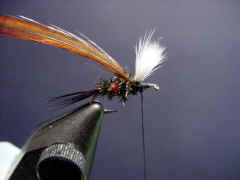|
Fly of the Month Bob Ireton brings together his experience in fly fishing, aquatic entomology, and knowledge of fly tying techniques and materials, to design and tie durable and effective flies. |

|
![]()
Volume 3, Issue 12
December 2002
![]()
Royal Wulf
Fly and Text by Bob Ireton
Photography by Bob Kimsey and Bob Ireton
Lee Wulf was born in Valdez, Alaska, in 1905. He loved being around water from the start, and began fishing around age two. At age nine, his father gave him a fly fishing outfit. He soon lost the few flies that came with the outfit, and out of necessity, started tying flies by holding the hook in his fingers, and using any materials he could find that would work. He would try to imitate flies pictured in the catalogs. He would continue to tie his flies by holding the hook in his fingers instead of a vice his entire life. Lee felt that he could tie flies faster and just as securely as if they were tied in a vice.
In the following years Lee would move to New York, California, Paris, and back to New York. His expertise in fly fishing and tying developed greatly during this time. It was around 1931 that the 'WULF' flies were developed, such as the Grizzly Wulf, the Black Wulf, the Brown Wulf, the Blonde Wulf, and the Royal Wulf. Lee was active in the sport his entire life, and is an American legend.
The Royal Wulf was developed to float well on rough water. It can be a little difficult to tie, considering all that is going on to tie it. Materials for the body and hackle are pretty standard; brown hackle, peacock herl, and red floss. For the tail, you can use moose body hair, deer or elk body hair, and for the wings, calf tail or body hair, deer body hair, or kid goat body hair. If you like, try tying this fly without using a vice. Personally, I am sticking with my trusty vice!
MATERIALS
Hook - TMC 100, Dai-Riki 300, Daiichi 1100, Mustad 94840, Orvis 1509 Size 8-20
Thread - Black 6/0 for larger sizes, and 8/0 for smaller sizes.
Wing - White calf body hair.
Tail - Moose body hair.
Body - Peacock herl and red floss.
Hackle - Coachman brown dry fly hackle.
TYING STEPS
![]()
Copyright © 1998 - thisyear The Buckeye United Fly Fishers, Inc. Cincinnati, OH 45242
The Buckeye United Fly Fishers, Inc is a non-profit corporation organized under section 501(c)(3) of the Internal Revenue Code, incorporated in the State of Ohio for the preservation, conservation and wise use of our fishing waters and game fish; and to assist in the protection and improvement of our natural resources





